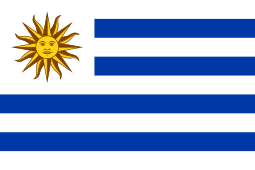Uruguay | History, Capital, Language, Flag, Facts & Geography of Uruguay
History of Uruguay:
Uruguay was originally inhabited by the Charrua Indians. After Spain conquered the country in 1516, they resisted conquest by the Spanish for years. From the 16th century to his 17th century, the Spaniards began to settle the land, bringing livestock to the area that later became an important economic engine.
Uruguay’s capital and largest city today, Montevideo was founded by the Spaniards in the early 18th century as a military base. In 1811, the Uruguayans launched a struggle for independence with the support of their leader, José Gervasio Artigas. After years of struggle, including merging with Brazil and joining the regional federation with Argentina, Uruguay became an independent state in 1825. Since then, Uruguay has developed into the country with the most liberal political and working conditions in South America.
Get Free Counseling
Information about Uruguay:
| Capital | Montevideo |
| Population | 3,423,108 (Source: 2023 worldometer) |
| Major Cities | Montevideo (capital), Salto, Ciudad de la Costa, Paysandú |
| Borders | Brazil to the north and east, by the Atlantic Ocean to the southeast, and by the Río de la Plata to the south, while the Uruguay River serves as its western boundary with Argentina |
| Gross Domestic Product (GDP) | $71,177,146,197 (2022 worldometer) |
| Currency | Uruguayan peso (UYU) |
Flag of Uruguay:
Uruguay Economy Key Industries:
Uruguay Major Industries: food processing, electrical machinery, transportation equipment, petroleum products, textiles, chemicals, beverages
Uruguay Agricultural Products: rice, wheat, corn, barley; livestock; fish
Uruguay Natural Resources: arable land, hydropower, minor minerals, fisheries
Uruguay Major Exports: meat, rice, leather products, wool, fish, dairy products
Uruguay Major Imports: machinery, chemicals, road vehicles, crude petroleum
The Geography of Uruguay:
Total Size of Uruguay: 176,215 sq km (source: 2022 The world factbook)
Geographical Low Point of Uruguay: Atlantic Ocean 0 m
Geographical High Point of Uruguay: Cerro Catedral 514 m
Climate of Uruguay: warm temperate; freezing temperatures almost unknown
General Terrain of Uruguay: mostly rolling plains and low hills; fertile coastal lowland
World Region or Continent of Uruguay: South America
Geographical Coordinates: 33 00 S, 56 00 W
The People of Uruguay & Culture
Uruguay Government Type: constitutional republic
Uruguay Nationality: Uruguayan(s)
Uruguay National Holiday: Independence Day, 25 August (1825)
Uruguay Independence: 25 August 1825 (from Brazil)
Uruguay National Symbol: Sun of May (a sun-with-face symbol)
Uruguay National Anthem or Song: Himno Nacional (National Anthem of Uruguay)
Uruguay Languages Spoken: Spanish, Portunol, or Brazilero (Portuguese-Spanish mix on the Brazilian frontier)
Uruguay Religions: Roman Catholic 66% (less than half of the adult population attends church regularly), Protestant 2%, Jewish 1%, nonprofessing or other 31%
Interesting Facts about Uruguay:
The name Uruguay means “river of drawn birds”.
We have the poorest politician in the world, Jose Mujica. Surprisingly, Uruguay has the poorest politicians in the world. Yes, their president lives frugally and donates 90% of his salary to charity. He has his one bedroom house and his three legged dog.
Montevideo, the capital of Uruguay, was the center of South America’s slave trade during colonial times. As a result, at least 10 percent of the country’s population are descendants of slaves.
Uruguay is the second smallest country in South America after Suriname.
Uruguay is the least religious country in America. As such, many traditional holidays have been renamed. Christmas is now called Family Day and Holy Week is Tourism Week.
Uruguayans go to bars not only to get drunk, but also to socialize.
Uruguay has the longest national anthem in the world in terms of musical length (105 bars, about 6 minutes).
Uruguay is the only country that tracks 100% of its livestock. There are three cows per person in this country.
In 1930 Uruguay hosted the first FIFA World Cup. Uruguay defeated Argentina 4-2 to win the FIFA World Cup that year.
Additionally, in 2009 Uruguay became the first country in the world to provide every schoolchild with a free laptop and her WiFi access. Suriname is the only country in South America smaller than Uruguay.
Forget the Andes. The highest point in Uruguay is Cerro Catedral, which is just 1,684 feet (514 meters) above sea level.
Uruguay is the only country in Latin America that is completely outside the tropics.
At more than five minutes, the Uruguayan national anthem is the longest performance in the world.
